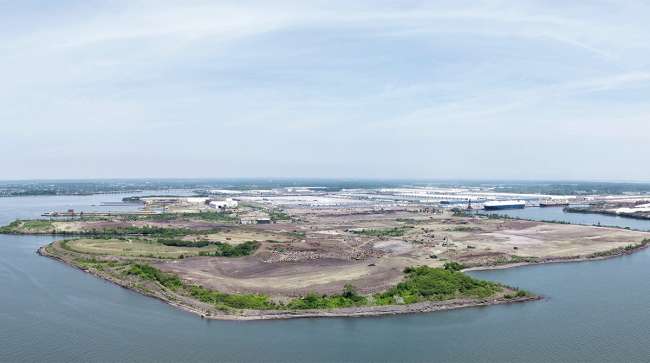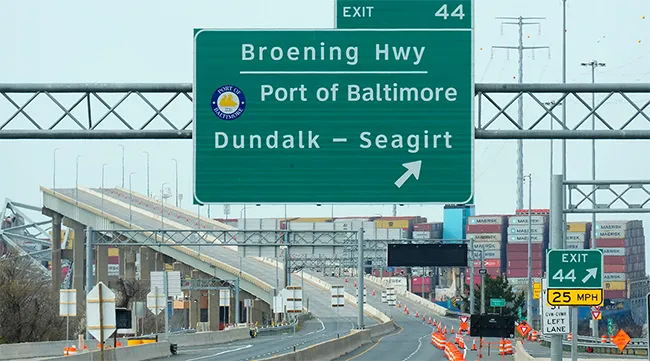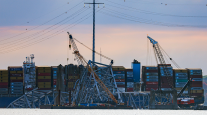Port of Baltimore Terminal to Have $1.54B Impact, Study Finds

[Stay on top of transportation news: Get TTNews in your inbox.]
A containership terminal planned for Sparrows Point is expected to transform Maryland's economy over a decade, generating more than 8,000 direct and Port of Baltimore-affiliated jobs and adding $1.54 billion a year in economic impact.
Developers of Tradepoint Atlantic, the site of the proposed terminal in Baltimore County, released the findings of an economic impact study July 16.
New jobs coming to Sparrows Point Container Terminal by 2035 are projected to generate more than $305 million in employee salaries, according to research by advisory firm Infrata. And $57 million in state and local tax revenue would be collected each year during that period, primarily through corporate and individual taxes.
The proposed terminal represents a “once-in-a-lifetime opportunity” to secure the Baltimore port’s standing for generations, Kerry Doyle, managing director of Tradepoint, said in a news release July 16.
Developers of Tradepoint, a logistics and distribution hub on the former site of Bethlehem Steel, previously said the $1 billion project was expected to create 1,100 jobs. The 8,000 figure over a decade represents a multiplier effect from container handling activity, both direct and port-affiliated jobs in surrounding communities, the study found.
Tradepoint is building the proposed terminal in Coke Point in partnership with a subsidiary of shipping giant Mediterranean Shipping Co., one of the world’s largest operators of containerships and the port’s largest shipping line. Tradepoint announced its joint investment and partnership with Terminal Investments Ltd. in October 2022.
Development of the terminal with an on-dock rail facility and support facilities is expected to create much-needed additional container-handling capacity in Baltimore and give the port a substantial competitive advantage along the East Coast. Mediterranean Shipping had said it needs additional container-handling capacity. The redevelopment site spans 330 acres and is expected to expand port operations by 70%.

The containership Dali rests against wreckage of the Francis Scott Key Bridge on March 26 as seen from Dundalk, Md. (Matt Rourke/Associated Press)
The need for such a terminal came into sharper focus after the Francis Scott Key Bridge disaster. The port, including its main container terminal, Seagirt, operated by Ports America off Broening Highway, was shut down for weeks after the freighter Dali struck the bridge in late March and caused it to collapse, killing six construction workers. The wreckage blocked access to most cargo vessels.
In the wake of the disaster, Tradepoint now hopes to speed up its terminal construction plans. The company convinced state legislators in the recent session to reopen the possibility of using Baltimore County’s Hart-Miller Island as a disposal site for dredged sediments. That would allow it to complete the new terminal two years earlier than the previously estimated 2028.
During the port shutdown, Tradepoint Atlantic operated the only Baltimore terminal open to large vessels because of its location south of the bridge at Sparrows Point, doubling its capacity for monthly automobile shipments by increasing storage and extending hours. Tradepoint’s existing terminal handles “roll-on/roll-off” vehicles, as well as bulk and breakbulk cargo, which are goods stowed on ships without being stored in containers.
The economic impact study reaffirmed the additional container terminal as a significant growth opportunity for the state, positioning Baltimore as a leading East Coast port and most efficient gateway to the Midwest for containerized cargo. The new terminal would offer the shortest rail distance to some of the biggest U.S. consumer markets.
Want more news? Listen to today's daily briefing above or go here for more info
“Through this investment we wish to create the required extra capacity to allow shipping lines to use Baltimore — in addition to its current hinterland — also as a major intermodal gateway,” said Tom Van Eynde, Terminal Investments’ terminal investments director for North America, said in the news release.
“This new facility will create thousands of new family sustaining jobs and ensure Baltimore’s position as a premier East Coast port,” said Scott Cowan, president of the International Longshoremen’s Association, Local 333, in the July 16 announcement.
The state is committed to working with Tradepoint, Gov. Wes Moore said in the release, “to maximize its potential and solidify Baltimore’s place as one of the most efficient ports in the nation.”
Distributed by Tribune Content Agency, LLC




